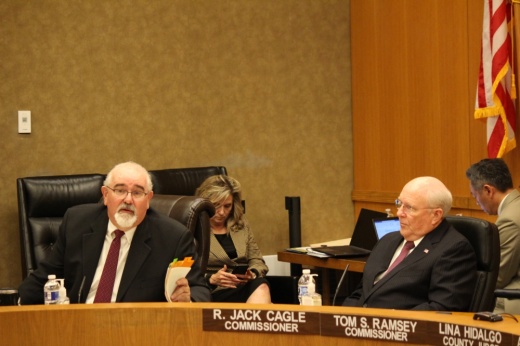For six consecutive meetings in September and October, Precinct 3 Commissioner Tom Ramsey and Precinct 4 Commissioner Jack Cagle refused to show. Their absences denied the court the four-member quorum necessary to hold a vote on a set of tax rates for the county’s general fund, the Harris County Flood Control District, the Port of Houston Authority and the hospital district—Harris Health System.
Even after Cagle and Precinct 2 Commissioner Adrian Garcia zeroed in on the same tax rate for the county’s general fund in their last-minute efforts to reach a deal, Ramsey and Cagle’s seats were empty Oct. 25 for the final opportunity to adopt proposed rates that were 1% lower overall than the previous year’s, according the Office of Management and Budget.
As a result, the county reverted to the no-new-revenue rates, under which the county’s property tax revenue is capped to the same amount as the previous year plus revenue from new construction minus any increases in debt.
With the combined overall rate of $0.53058 per $100 valuation, an owner of a home appraised at $300,000 eligible for the 20% homestead exemption will pay $101 less than if the proposed rate had been adopted. The difference between the proposed and adopted rates amounts to $94.2 million, $23.4 million and $135.7 million less in maintenance and operations revenue for the county’s general fund, the flood control district and Harris Health System, respectively, according to the budget office.
"Just remember when your flood control project is downsized [and] when your hospital wait times get longer, you know who to thank for that," County Judge Lina Hidalgo said Oct. 25.
Ramsey and Cagle said in Oct. 25 statements they were proud to save county taxpayers collectively around $250 million in taxes.
“We can return to a fiscally sound system of providing the basic services that taxpayers expect—public safety, flood protection, parks and constituent service,” Cagle said in a statement.
But with Cagle defeated by Democrat Lesley Briones in the Nov. 8 election, only Ramsey will be left to debate tax rates with Democrats in 2023.
Law enforcement funding
Several commissioners proposed more funding for law enforcement during the six-week long standoff. Ramsey asked for $20 million for 200 patrol officers; Cagle suggested $56 million for 200 new officers and salary increases for current officers; and Garcia proposed an additional 2.5% pay increase for law enforcement and $20 million for 200 deputy positions.
None of these proposals came to fruition. While the eight constable precincts, district attorney's office and sheriff's office's patrol will have $28.7 million more than in the previous full fiscal year, they missed out on $30.15 million in additional revenue.
Daniel Ramos, executive director of the Office of Management and Budget, said all county departments are paying around 10% more in costs due to inflation and increases in the cost of health care, thus impacting their ability to maintain the same level of service as they have in 2022.
“What we’re seeing across all departments is that departments will have less flexibility,” Ramos told Community Impact. “Under the no-new-revenue budget, we’ve eliminated planned investments, such as the 35 investigators for the sheriff to reduce caseloads for violent crimes.”
Cagle said in August he believed there would need to be a compelling reason to raise taxes, adding that if taxpayers have had to tighten their belts, the government should as well. Jason Spencer, spokesperson for the sheriff’s office, took a different view. The sheriff’s office’s patrol lost out on $16.68 million—the equivalent of 175 entry-level deputies.
“I don’t think there was an expectation that among our general public, that there would be a cut to law enforcement that we’ve seen with this budget,” Spencer said.
Hospital, flood control districts
Throughout the tax rate standoff, medical professionals, Harris Health System representatives and members of the public showed support for the hospital district's proposed tax rate of $0.173 per $100 valuation.
On Sept. 6, Dr. Esmaeil Porsa, Harris Health’s president and CEO, spoke virtually to warn of the impacts of the no-new-revenue rate of $0.148 per $100 valuation on the district.
“This is really shameful: we are 3,000 colonoscopies behind. We still have sewer water backing up to our pharmacy at our hospitals,” Porsa said.
He said Sept. 13 the hospital district’s tax rate had been cut twice over the last three years. The district’s rate was $0.162 per $100 valuation in the previous full fiscal year 2021-22—lower than that of other large Texas counties, with Tarrant County at $0.224, Dallas County at $0.255 and Bexar County at $0.276, according to an Oct. 17 presentation by Porsa.
In a stopgap measure, commissioners unanimously approved $45 million in federal American Rescue Plan Act funding Nov. 15 for Harris Health System, which has to be approved again at a second meeting after a plan for the money has been presented.
ARPA funding, though, is a one-time injection of cash: the difference in revenue between the proposed tax rate and no-new-revenue rate will have long-term effects, Porsa said Sept. 13.
“[It’s] not just a loss this year—next year, even if you went to the voter-approval rate, we’re still not going to be able to fill ... the hole that this is going to leave,” Porsa said.
As for the flood control district, Executive Director Tina Petersen said in a statement the no-new-revenue rate will impact the district’s maintenance programs, including a reduction in planned maintenance cycles for vegetation management, property clearing and other preventive maintenance services.
She said the district will prioritize active projects for completion, but will need to defer some projects to future fiscal years.
“The [district] is committed to delivering projects and providing flood infrastructure services to the residents and businesses of Harris County, even with the recent budget reductions,” Petersen said.
Road map for 2023
Going into the new year, Ramos said it will be up to the commissioners to decide how to amend budgets and conduct transfers to meet needs.
“[The budget office] will be doing quarterly projections on expenditures and revenues this January. At that point, we’ll make recommendations to Commissioners Court on which departments, if any, to restore funding to,” Ramos said.
The court’s composition and a shifting political environment could have an effect on those discussions.
Brandon Rottinghaus, a political science professor at the University of Houston, said commissioners court positions had historically been political in name only; from FY 2007-08 to FY 2018-19, a 4-1 Republican majority held the tax rate flat at around $0.63 per $100 valuation.
“We haven’t actually seen partisan politics come into play until the last couple of years where national politics has seeped into every pore of local politics,” Rottinghaus said.
Once the Democrats gained the majority in 2019, they attempted to raise the county’s tax rate, leading to a quorum break by Cagle and then-Precinct 3 Commissioner Steve Radack and preventing the increase. The tax rate has been reduced each year since.
While county’s budget growth is limited by Senate Bill 2—signed into law in June 2019 and requiring a city or county to hold an election if it proposes exceeding 3.5% more revenue than the previous fiscal year—as the court’s sole Republican in 2023, Ramsey cannot prevent the adoption of a higher tax rate next year.
“Democrats and Republicans are going to have different ideas about how to spend money and what the budget should look like and what the rate should be,” Rottinghaus said. “That’s going to create political friction, and Democrats will win ... [they] have got the votes.”





